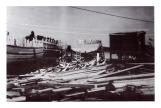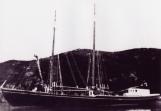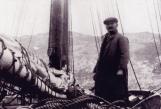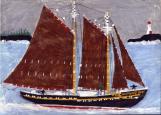1
'Katrina Charlene' built at the 'Glovertown Shipyard'2002
Glovertown Shipyard, Glovertown, Newfoundland & Labrador, Canada
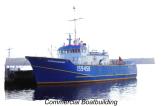
3
Mr. George Vatcher Parsons (1878-1942) came to Glovertown in 1906. He turned his efforts primarily to boatbuilding around 1934, making Glovertown North one of the leading dockyards in Bonavista Bay. The main vessels built in his dockyard were: 'Short Wave' (1934), 'Golden Glow' (1934), 'Harriett Walton' (1935), 'Eric Keith' (1936), 'Dawn Kiss' (1937), 'Arthur Maxwell' (1941).These vessels were primarily seventy-to-eighty-ton two-masted fishing schooners. Although each one had its unique characteristics, and although for each one Captain Parsons adapted ideas used previously, here is a general description which illustrates how the vessels were built:
Captain George Parsons, the master builder, would prepare the model, select a suitable level place by the water-side at Glovertown North, and hire the best boatbuilders he could find to use the timber and planks he had purchased locally or had cut for his own sawmill. Keel blocks were laid and the keel placed upon them. The keel was made up of large timbers scarphed together. The foreman (who was often Edgar Paul) then carefully marked upon the keel the location of the stem and stern-post which were installed next. Then the forebend, the midshipbend, and the afterbend were fastened to the keel and kept in place by scaffolding and struts. These bends were timbers sawed or chopped into necessary shapes by Glovertown loggers. The battens were lashed to these bends - far more on one side than on the other because once a timber was shaped its twin for the other side was modeled after it. Then the stern, already shaped by the battens, was installed. Timbers, usually five inches by five inches or six inches by six inches, were then fitted following the shape created by the battens.
The skeleton of the vessel was now said to be "in frame," and after all was lined up to the satisfaction of the master builder the strengthening timbers were placed in the vessel. The first of these was the keelson, laid over the timbers and on top of the keel. Then the ceiling, or inside planking, was installed. When the vessel was ceiled up to the height of the deck the shelf and clamp timbers were bolted on, these timbers being scarphed together to form a horizontal strake running the whole length of the ship. Upon them the ends of the deck beams would rest. The deck beams were fitted with heavy knees to brace them and after that the vessel could be decked. When the ceiling was finished and the beams fitted and bolted the vessel was ready for outside planking.
Planking was usually done from the keel upwards and the planks were fastened to the timbers with iron or copper bolts or tree-nails which were often called trunnels, the latter being a wooden bolt driven through planking, timbers, and ceiling, split across the ends, and wedged so that it could not work out. When the vessel was planked, the seams and the decking were made water-tight by caulking, Hatch coamings were fitted, deck houses erected, the rudder hung in place, all necessary blacksmith work completed, and the vessel painted. The vessel was then ready for launching.
Some Parsons boats were practically finished on the stocks with all masts stepped, the rigging put in place, and the yards and poles nailed aloft. Others went into the water as bare hulls to be sparred and rigged in Alexander Bay harbor. Prior to the sending of a vessel overboard, a cradle would be constructed under her upon a well-greased launching slipway. The hull was raised off the blocks, blocks and shores knocked out until the vessel rested upon the cradle. When the time of high tide approached, a traditional christening ceremony took place, the cradle was released, and on the sloping greased slipway the vessel slipped out into Alexander Bay.
In Glovertown the launching of a Parsons vessel, whether by day or by night, was a newsworthy community event. People from all around the bay came to celebrate another achievement in local craftsmanship. It is said that the record for slipway speed goes to the 'Harriett Walton' - 160 feet in fifteen seconds.
4
The last schooner built at the 'Parsons Dockyard'1944
Glovertown North, Newfoundland & Labrador, Canada

5
We believe the people posing for this picture are as follows (l-r): Douglas Holloway, Belle Holloway, Edwina Holloway, Lucy Burry, Edith Vivian.6
The Parsons entrepreneurship in the shipbuilding trade was crucially important to the economy of Glovertown in the Dirty Thirties.7
A scene from the 'Burry Dockyard'1945
'Burry Dockyard,' Glovertown, Newfoundland & Labrador, Canada
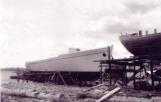
8
The Burry family has played a big role in Glovertown's long history especially in boatbuilding. It was boatbuilding more than any other factor, perhaps, that set the course for economic recovery in 1946 when the fire destroyed many homes and much other property in Glovertown. In that year, Captain Max Burry, his home ravaged by fire, contemplated leaving Glovertown to find employment away from the call of ships which was in his blood. Then Job Hiscock from Flat Island in Bonavista Bay arrived at Glovertown and asked Captain Max to build the 'National Convention,' a 96-ton fishing schooner which later became a coastal trader, and still later, a private yacht in California. Captain Max stayed and put together the package of manpower and administration necessary to build such a boat in those days of desperation in Glovertown.Vessel followed vessel, until Captain Max himself had become the energetic and prosperous entrepreneur responsible for the creation of about one hundred vessels, including many that were built entirely at his dockyard in Glovertown at the western end of Alexander Bay and some that came here to be refitted or repaired or refinished.
10
Baxter Burry is one of Glovertown's shipbuilding pioneers. He is also a famous sea captain. Here he is in St. John's with the South Side Hills in the background.11
A scene from the 'Burry Dockyard'1955
'Burry Dockyard,' Glovertown, Newfoundland & Labrador, Canada
